Photo’s: Colour or Black & White. Which do you prefer, and why.
When it comes to photography, one of the most fundamental decisions you'll have to make is whether to shoot in colour or black and white. Both colour and black and white have their advantages and disadvantages, and the choice ultimately depends on the photographer's goals and intentions.
If you're looking to capture the mood and atmosphere of a scene, black and white photography can be a powerful tool. By removing colour from the equation, you're forced to focus on the other elements of the image, such as contrast, texture, and composition. Black and white photography can also evoke a sense of nostalgia and timelessness, making it ideal for capturing historical moments or landscapes.






